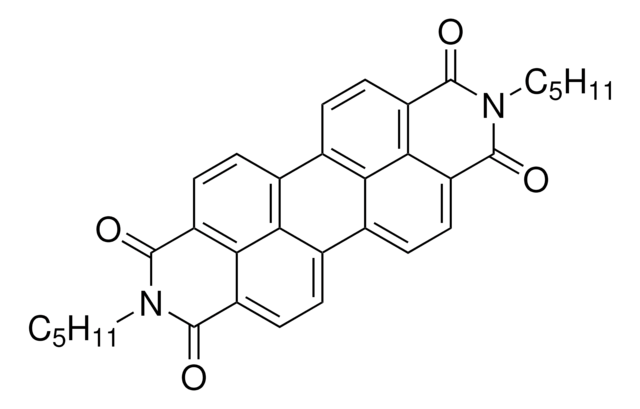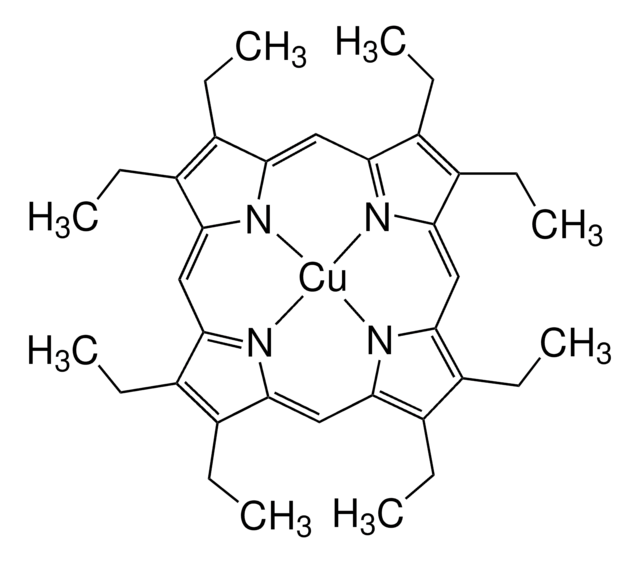264229
N,N′-Bis(2,5-di-tert-butylphenyl)-3,4,9,10-perylendicarboximid
Dye content 97 %
About This Item
Empfohlene Produkte
Assay
97%
Form
solid
Zusammensetzung
Dye content, 97%
mp (Schmelzpunkt)
>300 °C (lit.)
λmax
528 nm
Halbleitereigenschaften
N-type (mobility=1.8x10−4 cm2/V·s)
SMILES String
CC(C)(C)c1ccc(c(c1)N2C(=O)c3ccc4c5ccc6C(=O)N(C(=O)c7ccc(c8ccc(C2=O)c3c48)c5c67)c9cc(ccc9C(C)(C)C)C(C)(C)C)C(C)(C)C
InChI
1S/C52H50N2O4/c1-49(2,3)27-13-23-37(51(7,8)9)39(25-27)53-45(55)33-19-15-29-31-17-21-35-44-36(22-18-32(42(31)44)30-16-20-34(46(53)56)43(33)41(29)30)48(58)54(47(35)57)40-26-28(50(4,5)6)14-24-38(40)52(10,11)12/h13-26H,1-12H3
InChIKey
BIYPCKKQAHLMHG-UHFFFAOYSA-N
Verwandte Kategorien
Allgemeine Beschreibung
Anwendung
Signalwort
Warning
H-Sätze
Gefahreneinstufungen
Eye Irrit. 2 - Skin Irrit. 2 - STOT SE 3
Zielorgane
Respiratory system
Lagerklassenschlüssel
11 - Combustible Solids
WGK
WGK 3
Flammpunkt (°F)
Not applicable
Flammpunkt (°C)
Not applicable
Persönliche Schutzausrüstung
dust mask type N95 (US), Eyeshields, Gloves
Analysenzertifikate (COA)
Suchen Sie nach Analysenzertifikate (COA), indem Sie die Lot-/Chargennummer des Produkts eingeben. Lot- und Chargennummern sind auf dem Produktetikett hinter den Wörtern ‘Lot’ oder ‘Batch’ (Lot oder Charge) zu finden.
Besitzen Sie dieses Produkt bereits?
In der Dokumentenbibliothek finden Sie die Dokumentation zu den Produkten, die Sie kürzlich erworben haben.
Artikel
Intrinsically stretchable active layers for organic field-effect transistors (OFET) are discussed. Polymer structural modification & post-polymerization modifications are 2 methods to achieve this.
Fabrication procedure of organic field effect transistor device using a soluble pentacene precursor.
Solution-processed organic photovoltaic devices (OPVs) have emerged as a promising clean energy generating technology due to their ease of fabrication, potential to enable low-cost manufacturing via printing or coating techniques, and ability to be incorporated onto light weight, flexible substrates.
Thin, lightweight, and flexible electronic devices meet widespread demand for scalable, portable, and robust technology.
Unser Team von Wissenschaftlern verfügt über Erfahrung in allen Forschungsbereichen einschließlich Life Science, Materialwissenschaften, chemischer Synthese, Chromatographie, Analytik und vielen mehr..
Setzen Sie sich mit dem technischen Dienst in Verbindung.









